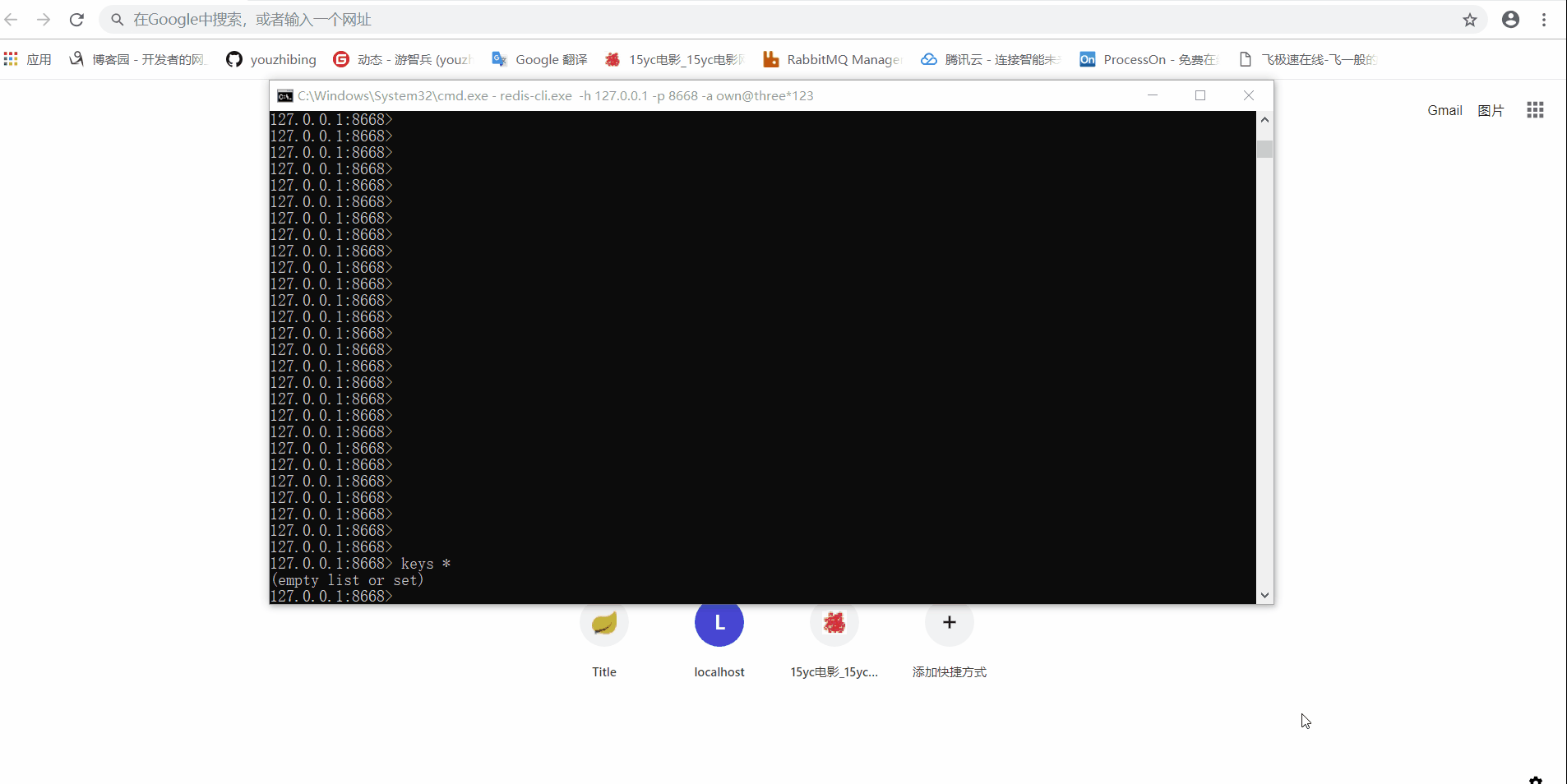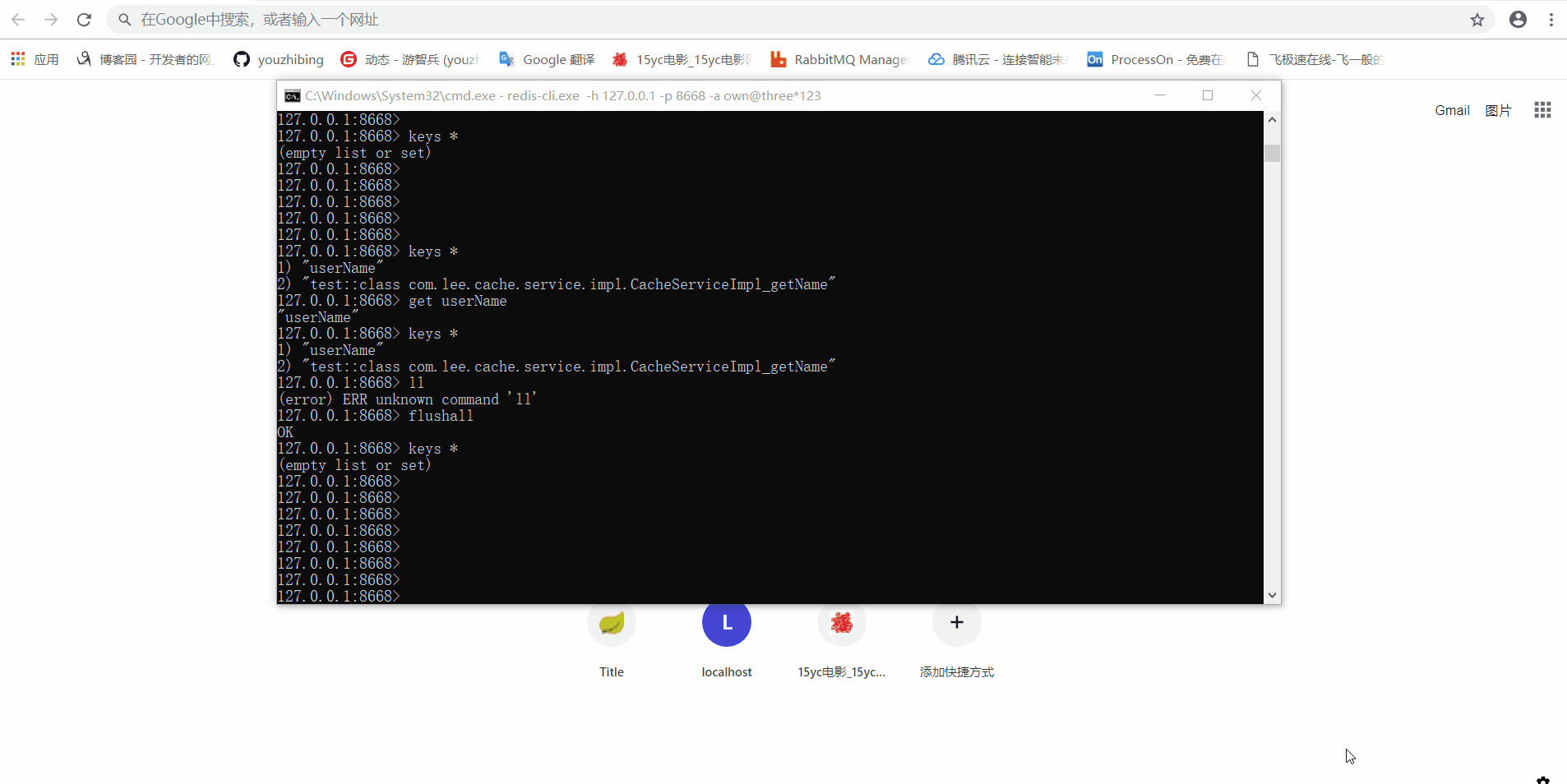spring-boot-2.0.3之redis缓存实现,不是你想的那样哦!
前言
开心一刻
小白问小明:“你前面有一个5米深的坑,里面没有水,如果你跳进去后该怎样出来了?”小明:“躺着出来呗,还能怎么出来?”小白:“为什么躺着出来?”小明:“5米深的坑,还没有水,跳下去不死就很幸运了,残是肯定会残的,不躺着出来,那能怎么出来?”小白:“假设没死也没残呢?”小明:“你当我超人了? 那也简单,把脑子里的水放出来就可以漂出来了。”小白:“你脑子里有这么多水吗?”小明:“我脑子里没那么多水我跳下去干嘛?”
路漫漫其修远兮,吾将上下而求索!
github:https://github.com/youzhibing
码云(gitee):https://gitee.com/youzhibing
springboot 1.x到2.x变动的内容还是挺多的,而2.x之间也存在细微的差别,本文不讲这些差别(具体差别我也不知道,汗......),只讲1.5.9与2.0.3的redis缓存配置的区别
springboot1.5.9缓存配置
工程实现
1.x系列配置应该都差不多,下面我们看看1.5.9中,springboot集成redis的缓存实现
pom.xml
<?xml version="1.0" encoding="UTF-8"?>
<project xmlns="http://maven.apache.org/POM/4.0.0"
xmlns:xsi="http://www.w3.org/2001/XMLSchema-instance"
xsi:schemaLocation="http://maven.apache.org/POM/4.0.0 http://maven.apache.org/xsd/maven-4.0.0.xsd">
<modelVersion>4.0.0</modelVersion> <groupId>com.lee</groupId>
<artifactId>spring-boot159.cache</artifactId>
<version>1.0-SNAPSHOT</version> <properties>
<java.version>1.8</java.version>
</properties> <parent>
<groupId>org.springframework.boot</groupId>
<artifactId>spring-boot-starter-parent</artifactId>
<version>1.5.9.RELEASE</version>
</parent> <dependencies> <dependency>
<groupId>org.springframework.boot</groupId>
<artifactId>spring-boot-starter-web</artifactId>
</dependency> <dependency>
<groupId>org.springframework.boot</groupId>
<artifactId>spring-boot-starter-data-redis</artifactId>
</dependency> </dependencies>
</project>
application.yml
server:
port: 8888
spring:
#redis配置
redis:
database: 0
host: 127.0.0.1
port: 6379
password:
# 连接超时时间(毫秒)
timeout: 2000
pool:
# 连接池最大连接数(使用负值表示没有限制)
max-active: 8
# 连接池最大阻塞等待时间(使用负值表示没有限制)
max-wait: -1
# 连接池中的最大空闲连接
max-idle: 8
# 连接池中的最小空闲连接
min-idle: 0
cache:
type: redis
cache:
expire-time: 180
RedisCacheConfig.java
package com.lee.cache.config; import com.fasterxml.jackson.annotation.JsonAutoDetect;
import com.fasterxml.jackson.annotation.PropertyAccessor;
import com.fasterxml.jackson.databind.ObjectMapper;
import org.springframework.beans.factory.annotation.Value;
import org.springframework.cache.CacheManager;
import org.springframework.cache.annotation.CachingConfigurerSupport;
import org.springframework.cache.annotation.EnableCaching;
import org.springframework.cache.interceptor.KeyGenerator;
import org.springframework.context.annotation.Bean;
import org.springframework.context.annotation.Configuration;
import org.springframework.data.redis.cache.RedisCacheManager;
import org.springframework.data.redis.connection.RedisConnectionFactory;
import org.springframework.data.redis.core.RedisTemplate;
import org.springframework.data.redis.core.StringRedisTemplate;
import org.springframework.data.redis.serializer.Jackson2JsonRedisSerializer; /**
* 必须继承CachingConfigurerSupport,不然此类中生成的Bean不会生效(没有替换掉默认生成的,只是一个普通的bean)
* springboot默认生成的缓存管理器和redisTemplate支持的类型很有限,根本不满足我们的需求,会抛出如下异常:
* org.springframework.cache.interceptor.SimpleKey cannot be cast to java.lang.String
*/
@Configuration
@EnableCaching
public class RedisCacheConfig extends CachingConfigurerSupport { @Value("${cache.expire-time:180}")
private int expireTime; // 配置key生成器,作用于缓存管理器管理的所有缓存
// 如果缓存注解(@Cacheable、@CacheEvict等)中指定key属性,那么会覆盖此key生成器
@Bean
public KeyGenerator keyGenerator() {
return (target, method, params) -> {
StringBuilder sb = new StringBuilder();
sb.append(target.getClass().getName());
sb.append(method.getName());
for (Object obj : params) {
sb.append(obj.toString());
}
return sb.toString();
};
} // 缓存管理器管理的缓存都需要有对应的缓存空间,否则抛异常:No cache could be resolved for 'Builder...
@Bean
public CacheManager cacheManager(RedisTemplate redisTemplate) {
RedisCacheManager rcm = new RedisCacheManager(redisTemplate);
rcm.setDefaultExpiration(expireTime); //设置缓存管理器管理的缓存的过期时间, 单位:秒
return rcm;
} @Bean
public RedisTemplate<String, String> redisTemplate(RedisConnectionFactory factory) {
StringRedisTemplate template = new StringRedisTemplate(factory);
Jackson2JsonRedisSerializer jackson2JsonRedisSerializer = new Jackson2JsonRedisSerializer(Object.class);
ObjectMapper om = new ObjectMapper();
om.setVisibility(PropertyAccessor.ALL, JsonAutoDetect.Visibility.ANY);
om.enableDefaultTyping(ObjectMapper.DefaultTyping.NON_FINAL);
jackson2JsonRedisSerializer.setObjectMapper(om);
template.setValueSerializer(jackson2JsonRedisSerializer);
template.afterPropertiesSet();
return template;
}
}
CacheServiceImpl.java
package com.lee.cache.service.impl; import com.lee.cache.model.User;
import com.lee.cache.service.ICacheService;
import org.springframework.beans.factory.annotation.Autowired;
import org.springframework.cache.annotation.Cacheable;
import org.springframework.data.redis.core.RedisTemplate;
import org.springframework.stereotype.Service;
import org.springframework.util.StringUtils; import java.util.ArrayList;
import java.util.List; /**
* 若未配置@CacheConfig(cacheNames = "hello"), 则@Cacheable一定要配置value,相当于指定缓存空间
* 否则会抛异常:No cache could be resolved for 'Builder...
*
* 若@CacheConfig(cacheNames = "hello") 与 @Cacheable(value = "123")都配置了, 则@Cacheable(value = "123")生效
*
* 当然@CacheConfig还有一些其他的配置项,Cacheable也有一些其他的配置项
*/
@Service
public class CacheServiceImpl implements ICacheService { @Autowired
private RedisTemplate<String, String> redisTemplate; @Override
@Cacheable(value = "test") // key用的自定义的KeyGenerator
public String getName() {
System.out.println("getName, no cache now...");
return "brucelee";
} @Override
@Cacheable(value = "user", key = "methodName + '_' + #p0", unless = "#result.size() <= 0") // key会覆盖掉KeyGenerator
public List<User> listUser(int pageNum, int pageSize) {
System.out.println("listUser no cache now...");
List<User> users = new ArrayList<>();
users.add(new User("zhengsan", 22));
users.add(new User("lisi", 20));
System.out.println("===========");
return users;
} /**
* 缓存不是缓存管理器管理,那么不受缓存管理器的约束
* 缓存管理器中的配置不适用与此
* 这里相当于我们平时直接通过redis-cli操作redis
* @return
*/
@Override
public String getUserName() { String userName = redisTemplate.opsForValue().get("userName");
if (!StringUtils.isEmpty(userName)) {
return userName;
} System.out.println("getUserName, no cache now...");
redisTemplate.opsForValue().set("userName", "userName");
return "userName";
} }
上述只讲了几个主要的文件,更多详情请点springboot159-cache
redis 怎样保存cache
大家一定要把工程仔细看一遍,不然下面出现的一些名称会让我们感觉不知从哪来的;

工程中的缓存分两种:缓存管理器管理的缓存(也就是一些列注解实现的缓存)、redisTemplate操作的缓存
缓存管理器管理的缓存
会在redis中增加2条数据,一个是类型为 zset 的 缓存名~keys , 里面存放了该缓存所有的key, 另一个是对应的key,值为序列化后的json;缓存名~keys可以理解成缓存空间,与我们平时所说的具体的缓存是不一样的。另外对缓存管理器的一些设置(全局过期时间等)都会反映到缓存管理器管理的所有缓存上;上图中的http://localhost:8888/getName和http://localhost:8888/listUser?pageNum=1&pageSize=3对应的是缓存管理器管理的缓存。
redisTemplate操作的缓存
会在redis中增加1条记录,key - value键值对,与我们通过redis-cli操作缓存一样;上图中的http://localhost:8888/getUserName对应的是redisTemplate操作的缓存。
spring2.0.3缓存配置
工程实现
pom.xml
<?xml version="1.0" encoding="UTF-8"?>
<project xmlns="http://maven.apache.org/POM/4.0.0"
xmlns:xsi="http://www.w3.org/2001/XMLSchema-instance"
xsi:schemaLocation="http://maven.apache.org/POM/4.0.0 http://maven.apache.org/xsd/maven-4.0.0.xsd">
<modelVersion>4.0.0</modelVersion> <groupId>com.lee</groupId>
<artifactId>spring-boot-cache</artifactId>
<version>1.0-SNAPSHOT</version> <parent>
<groupId>org.springframework.boot</groupId>
<artifactId>spring-boot-starter-parent</artifactId>
<version>2.0.3.RELEASE</version>
</parent> <dependencies> <dependency>
<groupId>org.springframework.boot</groupId>
<artifactId>spring-boot-starter-web</artifactId>
</dependency> <dependency>
<groupId>org.springframework.boot</groupId>
<artifactId>spring-boot-starter-data-redis</artifactId>
</dependency>
<dependency>
<groupId>org.apache.commons</groupId>
<artifactId>commons-pool2</artifactId>
</dependency>
<dependency>
<groupId>org.apache.commons</groupId>
<artifactId>commons-lang3</artifactId>
</dependency> </dependencies>
</project>
application.yml
server:
port: 8889
spring:
#redis配置
redis:
database: 0
host: 127.0.0.1
port: 6379
password:
lettuce:
pool:
# 接池最大连接数(使用负值表示没有限制)
max-active: 8
# 连接池最大阻塞等待时间(使用负值表示没有限制)
max-wait: -1ms
# 连接池中的最小空闲连接
max-idle: 8
# 连接池中的最大空闲连接
min-idle: 0
# 连接超时时间
timeout: 2000ms
cache:
type: redis
cache:
test:
expire-time: 180
name: test
default:
expire-time: 200
缓存定制:RedisCacheManagerConfig.java
package com.lee.cache.config; import org.springframework.beans.factory.annotation.Value;
import org.springframework.cache.CacheManager;
import org.springframework.context.annotation.Bean;
import org.springframework.context.annotation.Configuration;
import org.springframework.data.redis.cache.RedisCacheConfiguration;
import org.springframework.data.redis.cache.RedisCacheManager;
import org.springframework.data.redis.connection.RedisConnectionFactory;
import org.springframework.data.redis.serializer.GenericJackson2JsonRedisSerializer;
import org.springframework.data.redis.serializer.RedisSerializationContext;
import org.springframework.data.redis.serializer.StringRedisSerializer; import java.time.Duration;
import java.util.HashMap;
import java.util.HashSet;
import java.util.Map;
import java.util.Set; /**
* 进行缓存管理的定制
* 可以不配置,采用springboot默认的也行
*/
@Configuration
public class RedisCacheManagerConfig { @Value("${cache.default.expire-time:1800}")
private int defaultExpireTime;
@Value("${cache.test.expire-time:180}")
private int testExpireTime;
@Value("${cache.test.name:test}")
private String testCacheName; //缓存管理器
@Bean
public CacheManager cacheManager(RedisConnectionFactory lettuceConnectionFactory) {
RedisCacheConfiguration defaultCacheConfig = RedisCacheConfiguration.defaultCacheConfig();
// 设置缓存管理器管理的缓存的默认过期时间
defaultCacheConfig = defaultCacheConfig.entryTtl(Duration.ofSeconds(defaultExpireTime))
// 设置 key为string序列化
.serializeKeysWith(RedisSerializationContext.SerializationPair.fromSerializer(new StringRedisSerializer()))
// 设置value为json序列化
.serializeValuesWith(RedisSerializationContext.SerializationPair.fromSerializer(new GenericJackson2JsonRedisSerializer()))
// 不缓存空值
.disableCachingNullValues(); Set<String> cacheNames = new HashSet<>();
cacheNames.add(testCacheName); // 对每个缓存空间应用不同的配置
Map<String, RedisCacheConfiguration> configMap = new HashMap<>();
configMap.put(testCacheName, defaultCacheConfig.entryTtl(Duration.ofSeconds(testExpireTime))); RedisCacheManager cacheManager = RedisCacheManager.builder(lettuceConnectionFactory)
.cacheDefaults(defaultCacheConfig)
.initialCacheNames(cacheNames)
.withInitialCacheConfigurations(configMap)
.build();
return cacheManager;
}
}
此类可不用配置,就用spring-boot自动配置的缓存管理器也行,只是在缓存的可阅读性上会差一些。有兴趣的朋友可以删除此类试试。
CacheServiceImpl.java
package com.lee.cache.service.impl; import com.lee.cache.model.User;
import com.lee.cache.service.ICacheService;
import org.apache.commons.lang3.StringUtils;
import org.springframework.beans.factory.annotation.Autowired;
import org.springframework.cache.annotation.CacheConfig;
import org.springframework.cache.annotation.Cacheable;
import org.springframework.data.redis.core.RedisTemplate;
import org.springframework.stereotype.Service; import java.util.ArrayList;
import java.util.List; /**
* 若未配置@CacheConfig(cacheNames = "hello"), 则@Cacheable一定要配置value
* 若@CacheConfig(cacheNames = "hello") 与 @Cacheable(value = "123")都配置了, 则@Cacheable(value = "123") 生效
*
* 当然@CacheConfig还有一些其他的配置项,Cacheable也有一些其他的配置项
*/
@Service
public class CacheServiceImpl implements ICacheService { @Autowired
private RedisTemplate<String, String> redisTemplate; @Override
@Cacheable(value = "test", key = "targetClass + '_' + methodName")
public String getName() {
System.out.println("getName, no cache now...");
return "brucelee";
} @Override
@Cacheable(value = "user", key = "targetClass + ':' + methodName + '_' + #p0", unless = "#result.size() <= 0")
public List<User> listUser(int pageNum, int pageSize) {
System.out.println("listUser no cache now...");
List<User> users = new ArrayList<>();
users.add(new User("zhengsan", 22));
users.add(new User("lisi", 20));
return users;
} /**
* 缓存不是缓存管理器管理,那么不受缓存管理器的约束
* 缓存管理器中的配置不适用与此
* 这里相当于我们平时直接通过redis-cli操作redis
* @return
*/
@Override
public String getUserName() { String userName = redisTemplate.opsForValue().get("userName");
if (StringUtils.isNotEmpty(userName)) {
return userName;
} System.out.println("getUserName, no cache now...");
redisTemplate.opsForValue().set("userName", "userName");
return "userName";
} }
更多详情请点spring-boot-cache
redis 怎样保存cache
我们来看图说话,看看缓存在redis中是如何保存的

工程中的缓存分两种:缓存管理器管理的缓存(也就是一些列注解实现的缓存)、redisTemplate操作的缓存
缓存管理器管理的缓存
会在redis中增加1条数据,key是以缓存空间开头的字符串(缓存空间名::缓存key),值为序列化后的json;上图中的http://localhost:8889/getName和http://localhost:8889/listUser?pageNum=1&pageSize=3对应的是缓存管理器管理的缓存。
redisTemplate操作的缓存
会在redis中增加1条记录,key - value键值对,与我们通过redis-cli操作缓存一样;上图中的http://localhost:8889/getUserName对应的是redisTemplate操作的缓存。
总结
1、有时候我们引入spring-boot-starter-cache这个starter只是为了快速添加缓存依赖,目的是引入spring-context-support;如果我们的应用中中已经有了spring-context-support,那么我们无需再引入spring-boot-starter-cache,例如我们的应用中依赖了spring-boot-starter-web,而spring-boot-starter-web中又有spring-context-support依赖,所以我们无需再引入spring-boot-starter-cache。
2、Supported Cache Providers,讲了支持的缓存类型以及默认情况下的缓存加载方式,可以通读下。
3、只要我们引入了redis依赖,并将redis的连接信息配置正确,springboot(2.0.3)根据我们的配置会给我们生成默认的缓存管理器和redisTemplate;我们也可以自定义我们自己的缓存管理器来替换掉默认的,只要我们自定义了缓存管理器和redisTemplate,那么springboot的默认生成的会替换成我们自定义的。
4、缓存管理器对缓存的操作也是通过redisTemplate实现的,只是进行了统一的管理,并且能够减少我们的代码量,我们可以将更多的精力放到业务处理上。
5、redis-cli -h 127.0.0.1 -p 6379 -a 123456与redis-cli -a 123456两种方式访问到的数据完全不一致,好像操作不同的库一样! 这个需要注意,有空我回头看看这两者到底有啥区别,有知道的朋友可以留个言。
最后缅怀一下:金庸走了,再无江湖;IG捧杯了,再无LOL!感谢IG成就了我的完美谢幕,让我的青春少了一份遗憾,谢谢!
参考
spring boot(三):Spring Boot中Redis的使用
spring-boot-2.0.3之redis缓存实现,不是你想的那样哦!的更多相关文章
- Spring Boot (五): Redis缓存使用姿势盘点
1. Redis 简介 Redis 是目前业界使用最广泛的内存数据存储.相比 Memcached,Redis 支持更丰富的数据结构,例如 hashes, lists, sets 等,同时支持数据持久化 ...
- 阿里P7级教你如何在Spring Boot应用程序中使用Redis
在Spring Boot应用程序中使用Redis缓存的步骤: 1.要获得Redis连接,我们可以使用Lettuce或Jedis客户端库,Spring Boot 2.0启动程序spring-boot-s ...
- spring boot 2.0.4 Redis缓存配置
spring boot 2 使用RedisTemplate操作redis存取对象时,需要先进行序列化操作 import org.springframework.cache.CacheManager; ...
- spring boot 2.0.0 + shiro + redis实现前后端分离的项目
简介 Apache Shiro是一个强大且易用的Java安全框架,执行身份验证.授权.密码学和会话管理.使用Shiro的易于理解的API,您可以快速.轻松地获得任何应用程序,从最小的移动应用程序到最大 ...
- 详细介绍Spring Boot 2.0的那些新特性与增强
以Java 8 为基准 Spring Boot 2.0 要求Java 版本必须8以上, Java 6 和 7 不再支持. 内嵌容器包结构调整 为了支持reactive使用场景,内嵌的容器包结构被重构了 ...
- Spring Boot 2.0 的快速入门(图文教程)
摘要: 原创出处 https://www.bysocket.com 「公众号:泥瓦匠BYSocket 」欢迎关注和转载,保留摘要,谢谢! Spring Boot 2.0 的快速入门(图文教程) 大家都 ...
- Spring Boot 2.0 新特性和发展方向
以Java 8 为基准 Spring Boot 2.0 要求Java 版本必须8以上, Java 6 和 7 不再支持. 内嵌容器包结构调整 为了支持reactive使用场景,内嵌的容器包结构被重构了 ...
- Spring Boot 2.0 版的开源项目云收藏来了!
给大家聊一聊云收藏从 Spring Boot 1.0 升级到 2.0 所踩的坑 先给大家晒一下云收藏的几个数据,作为一个 Spring Boot 的开源项目(https://github.com/cl ...
- 【2.0新特性】Spring Boot 2.0新特性
以Java 8 为基准 Spring Boot 2.0 要求Java 版本必须8以上, Java 6 和 7 不再支持. 内嵌容器包结构调整 为了支持reactive使用场景,内嵌的容器包结构被重构了 ...
随机推荐
- 学生管理系统(Java Swing JDBC MySQL)
该系统使用 Java Swing.JDBC.MySQL 开发 开发环境 Eclipse.WindowBuilder JDK版本:1.8 代码在百度网盘中(176***5088) 目录结构如下 Data ...
- Spring Boot 启动(二) Environment 加载
Spring Boot 启动(二) Environment 加载 Spring 系列目录(https://www.cnblogs.com/binarylei/p/10198698.html) 上一节中 ...
- C# Chart控件教程
一.什么是Micosoft.Chart.Controls Micosoft.Chart.Controls是微软自带的一个图形可视化的组件,可以在Web程序和窗体程序中(Windowsform)中使用. ...
- JSP :使用<%@include%>报Duplicate local variable path 错误
今天在做商城页面,遇到问题: <%@include file="menu.jsp" %> 错误提示: Multiple annotations found at thi ...
- QT中报错collect2:ld returned 1 exit status的可能原因。
参考:https://blog.csdn.net/u014546553/article/details/78781547 1.编译成功的例子在后台执行,有时一闪而过,如果再次build ,则会提示上述 ...
- pycharm 如何进行全部搜索
界面里面先按ctrl F 弹出搜索页面 在搜索框内连续按两次shift shift可以搜索全文
- tomcat的调优管理
1 记性调整存设定. A: 方法如下: 1. linux 下编辑tomcat安装目录下的bin目录下的catalina.sh文件,windows下为catalina.bat vi catalina. ...
- 9.3AspectJ
1.1 介绍 AspectJ是一个基于Java语言的AOP框架 Spring2.0以后新增了对AspectJ切点表达式支持 @AspectJ 是AspectJ1.5新增功能,通过JDK5注解技术,允许 ...
- iOS架构模式浅析
这是以前旧博客在13年规划写的一个系列,写了一部分内容,还没有完成.现在重新整理编写.计划从基础知识六大设计原则.设计模式中类的关系开始,然后会对iOS开发中的常用架构模式进行介绍,最后对GoF的23 ...
- 背水一战 Windows 10 (70) - 控件(控件基类): UIElement - Transform3D(3D变换), Projection(3D投影)
[源码下载] 背水一战 Windows 10 (70) - 控件(控件基类): UIElement - Transform3D(3D变换), Projection(3D投影) 作者:webabcd 介 ...
